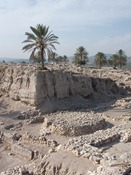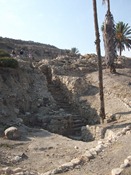The Beard Goes Home is an ongoing chronicle of my trip to Israel, Cairo and Rome from November 3-18. If you want more information on a picture, hover your mouse over it for a pop-up caption. If you want to see a bigger version of the picture, click on it.
On our way back to Jerusalem, Thomas and I decided to stop off at Mt. Megiddo. We left Tiberius and drove southwest, passing just a few miles south of Nazareth and through the Valley of Jezreel. Jezreel was the site of quite a few bloody battles, and most of them did not turn out well for Israel. By the 7th century BCE, the place had already acquired a pretty awful reputation (God told Hosea to name one of his sons Jezreel; this would be sort of like naming a child today Auschwitz). It was sometimes known as the Valley of Slaughter.
 Mt. Megiddo is at one end of the Jezreel Valley, and it was inhabited steadily from about 3,000 BCE until the 4th century BCE or so. The Canaanites first lived there, and today you can see an ancient Canaanite worship space – archaeologists have identified 17 layers of Canaanite temples. The Canaanites’ chief god was Ba’al the storm god; Israel often turned away from God to worship Ba’al and his goddess wife, Asherah.
Mt. Megiddo is at one end of the Jezreel Valley, and it was inhabited steadily from about 3,000 BCE until the 4th century BCE or so. The Canaanites first lived there, and today you can see an ancient Canaanite worship space – archaeologists have identified 17 layers of Canaanite temples. The Canaanites’ chief god was Ba’al the storm god; Israel often turned away from God to worship Ba’al and his goddess wife, Asherah.
After Israel conquered the Canaanites, Mt. Megiddo was fought over by pretty much everyone. It’s been ruled over by Egyptians, Israelites and Assyrians. In fact, the Egyptians killed King Josiah – one of the most faithful of Israel’s kings – at Megiddo.
 Another of Israel’s kings, Ahab, turned Mt. Megiddo into one of his three major centers of government. Much like Herod did to Masada, Ahab transformed Mt. Megiddo into a luxurious palace complex complete with stables for hundreds of horses. He even dug a tunnel through the mountain (which is really more hill-like) to the spring at the foot of Megiddo, so that during a siege the city still had access to water. Ahab was one of Israel’s most politically successful kings, but the Scriptures judge him as a failure because he openly embraced Ba’al worship thanks to his wife, Jezebel. Mt. Megiddo’s long history of Ba’al worship
Another of Israel’s kings, Ahab, turned Mt. Megiddo into one of his three major centers of government. Much like Herod did to Masada, Ahab transformed Mt. Megiddo into a luxurious palace complex complete with stables for hundreds of horses. He even dug a tunnel through the mountain (which is really more hill-like) to the spring at the foot of Megiddo, so that during a siege the city still had access to water. Ahab was one of Israel’s most politically successful kings, but the Scriptures judge him as a failure because he openly embraced Ba’al worship thanks to his wife, Jezebel. Mt. Megiddo’s long history of Ba’al worship  might be part of what drew Ahab there in the first place.
might be part of what drew Ahab there in the first place.
After the Assyrians conquered Israel (including Mt. Megiddo), they fell to the Persians and Mt. Megiddo lay an abandoned ruin at the edge of the Valley of Slaughter. It had a long history of idol worship and warfare, and was a place of shame and sin in the Hebrew culture.
The Hebrew word for ‘mountain’ is har. But the New Testament was written in Greek, which doesn’t have an ‘h’ sound, so Har Megiddo became Armegiddo. Here’s what John saw in the Revelation he received:
I saw three foul spirits like frogs coming from the mouth of the dragon, from the mouth of the beast and from the mouth of the false prophet. These are demonic spirits, performing signs, who go abroad to the kings of the whole world, to assemble them for battle on the great day of God the Almighty. And they assembled them at the place that in Hebrew is called Armageddon. – Revelation 16:13-16
That’s right, everyone. I made it to the end of the world. I just showed up a little bit early (Which was fine with me). With everything that Mt. Megiddo represented to a person shaped by the Old Testament, is it any wonder that John chose this place as the site where the Unholy Trinity would gather their forces to wage war on the Kingdom of God?

